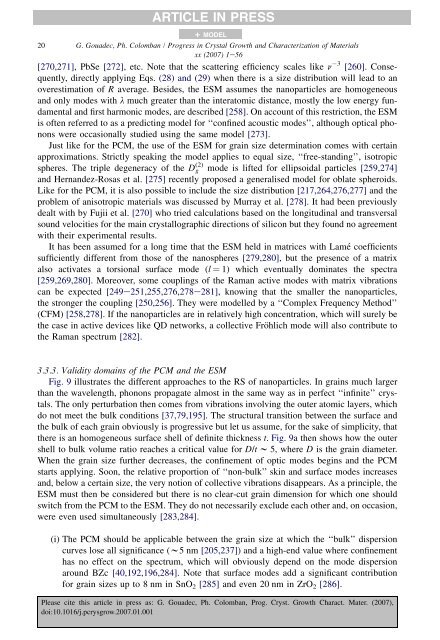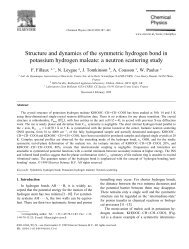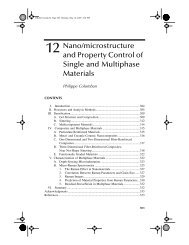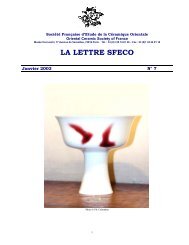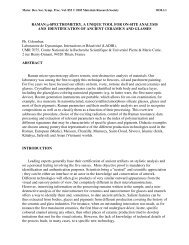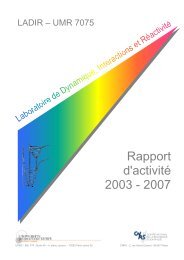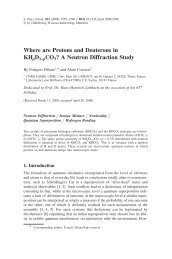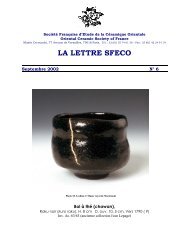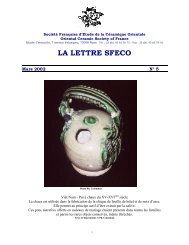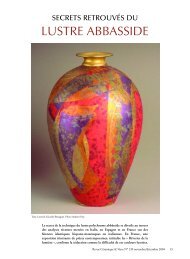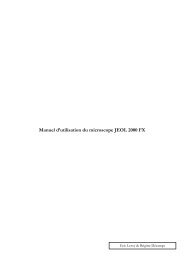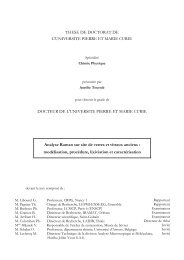Raman Spectroscopy of nanomaterials - institut de chimie et des ...
Raman Spectroscopy of nanomaterials - institut de chimie et des ...
Raman Spectroscopy of nanomaterials - institut de chimie et des ...
You also want an ePaper? Increase the reach of your titles
YUMPU automatically turns print PDFs into web optimized ePapers that Google loves.
ARTICLE IN PRESS+ MODEL20 G. Goua<strong>de</strong>c, Ph. Colomban / Progress in Crystal Growth and Characterization <strong>of</strong> Materialsxx (2007) 1e56[270,271], PbSe [272], <strong>et</strong>c. Note that the scattering efficiency scales like n 3 [260]. Consequently,directly applying Eqs. (28) and (29) when there is a size distribution will lead to anoverestimation <strong>of</strong> R average. Besi<strong>de</strong>s, the ESM assumes the nanoparticles are homogeneousand only mo<strong>de</strong>s with l much greater than the interatomic distance, mostly the low energy fundamentaland first harmonic mo<strong>de</strong>s, are <strong>de</strong>scribed [258]. On account <strong>of</strong> this restriction, the ESMis <strong>of</strong>ten referred to as a predicting mo<strong>de</strong>l for ‘‘confined acoustic mo<strong>de</strong>s’’, although optical phononswere occasionally studied using the same mo<strong>de</strong>l [273].Just like for the PCM, the use <strong>of</strong> the ESM for grain size <strong>de</strong>termination comes with certainapproximations. Strictly speaking the mo<strong>de</strong>l applies to equal size, ‘‘free-standing’’, isotropicspheres. The triple <strong>de</strong>generacy <strong>of</strong> the D (2) g mo<strong>de</strong> is lifted for ellipsoidal particles [259,274]and Hernan<strong>de</strong>z-Rosas <strong>et</strong> al. [275] recently proposed a generalised mo<strong>de</strong>l for oblate spheroids.Like for the PCM, it is also possible to inclu<strong>de</strong> the size distribution [217,264,276,277] and theproblem <strong>of</strong> anisotropic materials was discussed by Murray <strong>et</strong> al. [278]. It had been previously<strong>de</strong>alt with by Fujii <strong>et</strong> al. [270] who tried calculations based on the longitudinal and transversalsound velocities for the main crystallographic directions <strong>of</strong> silicon but they found no agreementwith their experimental results.It has been assumed for a long time that the ESM held in matrices with Lamé coefficientssufficiently different from those <strong>of</strong> the nanospheres [279,280], but the presence <strong>of</strong> a matrixalso activates a torsional surface mo<strong>de</strong> (l ¼ 1) which eventually dominates the spectra[259,269,280]. Moreover, some couplings <strong>of</strong> the <strong>Raman</strong> active mo<strong>de</strong>s with matrix vibrationscan be expected [249e251,255,276,278e281], knowing that the smaller the nanoparticles,the stronger the coupling [250,256]. They were mo<strong>de</strong>lled by a ‘‘Complex Frequency M<strong>et</strong>hod’’(CFM) [258,278]. If the nanoparticles are in relatively high concentration, which will surely b<strong>et</strong>he case in active <strong>de</strong>vices like QD n<strong>et</strong>works, a collective Fröhlich mo<strong>de</strong> will also contribute tothe <strong>Raman</strong> spectrum [282].3.3.3. Validity domains <strong>of</strong> the PCM and the ESMFig. 9 illustrates the different approaches to the RS <strong>of</strong> nanoparticles. In grains much largerthan the wavelength, phonons propagate almost in the same way as in perfect ‘‘infinite’’ crystals.The only perturbation then comes from vibrations involving the outer atomic layers, whichdo not me<strong>et</strong> the bulk conditions [37,79,195]. The structural transition b<strong>et</strong>ween the surface andthe bulk <strong>of</strong> each grain obviously is progressive but l<strong>et</strong> us assume, for the sake <strong>of</strong> simplicity, thatthere is an homogeneous surface shell <strong>of</strong> <strong>de</strong>finite thickness t. Fig. 9a then shows how the outershell to bulk volume ratio reaches a critical value for D/t w 5, where D is the grain diam<strong>et</strong>er.When the grain size further <strong>de</strong>creases, the confinement <strong>of</strong> optic mo<strong>de</strong>s begins and the PCMstarts applying. Soon, the relative proportion <strong>of</strong> ‘‘non-bulk’’ skin and surface mo<strong>de</strong>s increasesand, below a certain size, the very notion <strong>of</strong> collective vibrations disappears. As a principle, theESM must then be consi<strong>de</strong>red but there is no clear-cut grain dimension for which one shouldswitch from the PCM to the ESM. They do not necessarily exclu<strong>de</strong> each other and, on occasion,were even used simultaneously [283,284].(i) The PCM should be applicable b<strong>et</strong>ween the grain size at which the ‘‘bulk’’ dispersioncurves lose all significance (w5 nm[205,237]) and a high-end value where confinementhas no effect on the spectrum, which will obviously <strong>de</strong>pend on the mo<strong>de</strong> dispersionaround BZc [40,192,196,284]. Note that surface mo<strong>de</strong>s add a significant contributionfor grain sizes up to 8 nm in SnO 2 [285] and even 20 nm in ZrO 2 [286].Please cite this article in press as: G. Goua<strong>de</strong>c, Ph. Colomban, Prog. Cryst. Growth Charact. Mater. (2007),doi:10.1016/j.pcrysgrow.2007.01.001


